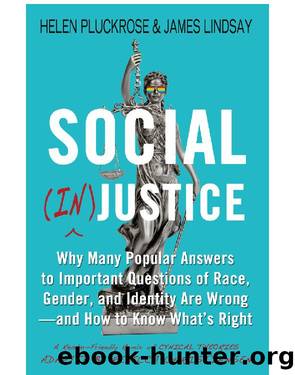Social (In)justice by Unknown

Author:Unknown
Language: eng
Format: epub
Published: 2022-02-20T16:00:00+00:00
The Death of Liberal Feminism
Liberal feminism works alongside secular, liberal democracy, individual agency within a framework of universal human rights, and an Enlightenment focus on reason and science. This made it the explicit, central target of postmodernists. Liberal feminists generally believe society already provides almost all the opportunities required for women to succeed in life. They just need the same access to those opportunities as men, along with measures that allow and protect that accessâeducational opportunities, affordable childcare, flexible working hours, and so on. Liberal feminists want to preserve the structures and institutions of secular, liberal democracy and open them up.
The intersectional feminists want a shift toward âmutual respectâ and âaffirmation of difference,â that is, a sense of solidarity and allyship among marginalized groups. This means respect for differences between social and cultural groups, not for individuals with different viewpoints. This requires cultural relativism and standpoint theoryâthe view that belonging to a marginalized group provides special access to truth, by allowing members insight into both dominance and their own oppression.
The understanding that different groups have different experiences, beliefs, and values was largely influenced by black feminists who criticized second-wave feminism for not recognizing that black women faced different prejudices and stereotypes than white women. bell hooksâ 1982 book, Ainât I a Woman?, was very influential in this regard. On the topic of black womenâs place in the feminist movement, hooks says,
When the womenâs movement began in the late 60s, it was evident that the white women who dominated the movement felt it was âtheirâ movement, that is the medium through which a white woman would voice her grievance to society. Not only did white women act as if feminist ideology existed solely to serve their own interests because they were able to draw public attention to feminist concerns. They were unwilling to acknowledge that non-white women were part of the collective group women in American society.
In her 1990 book, Black Feminist Thought, Patricia Hill Collins describes the stereotypes that uniquely affect African American women. She traces several stereotypes she saw as excluded from (white) feminismâincluding The Mammy, a servant figure; The Matriarch, an assertive (and therefore un-feminine) ruler of her family; The Welfare Mother, a passive baby-making machine; and The Jezebel, a sexually aggressive and sexually available black womanâback to tropes used to justify slavery.
However, (white) feminists including these racialized sexist tropes in their fight against patriarchy didnât go down well with Collins either. She writes in a 1993 essay:
The longstanding effort to âcolorizeâ feminist theory by inserting the experiences of women of color represents at best genuine efforts to reduce bias in Womenâs Studies. But at its worst, colorization also contains elements of both voyeurism and academic colonialism.
In the âincreasingly sophisticatedâ new Theory, it seems impossible to do anything right. The needle Collins expects (white) feminists to thread involves including, but not appropriating, the experiences of women of color, providing space for them to be heard, and amplifying their voicesâwithout exploiting them or becoming voyeuristic consumers of their oppression.
Download
This site does not store any files on its server. We only index and link to content provided by other sites. Please contact the content providers to delete copyright contents if any and email us, we'll remove relevant links or contents immediately.
Cecilia; Or, Memoirs of an Heiress — Volume 1 by Fanny Burney(32383)
Cecilia; Or, Memoirs of an Heiress — Volume 3 by Fanny Burney(31757)
Cecilia; Or, Memoirs of an Heiress — Volume 2 by Fanny Burney(31724)
The Great Music City by Andrea Baker(31093)
We're Going to Need More Wine by Gabrielle Union(18911)
All the Missing Girls by Megan Miranda(15410)
Pimp by Iceberg Slim(14230)
Bombshells: Glamour Girls of a Lifetime by Sullivan Steve(13933)
Talking to Strangers by Malcolm Gladwell(13141)
Norse Mythology by Gaiman Neil(13137)
Fifty Shades Freed by E L James(13128)
For the Love of Europe by Rick Steves(12369)
Crazy Rich Asians by Kevin Kwan(9132)
Mindhunter: Inside the FBI's Elite Serial Crime Unit by John E. Douglas & Mark Olshaker(9112)
The Lost Art of Listening by Michael P. Nichols(7365)
Enlightenment Now: The Case for Reason, Science, Humanism, and Progress by Steven Pinker(7090)
The Four Agreements by Don Miguel Ruiz(6550)
Bad Blood by John Carreyrou(6483)
Weapons of Math Destruction by Cathy O'Neil(6090)
